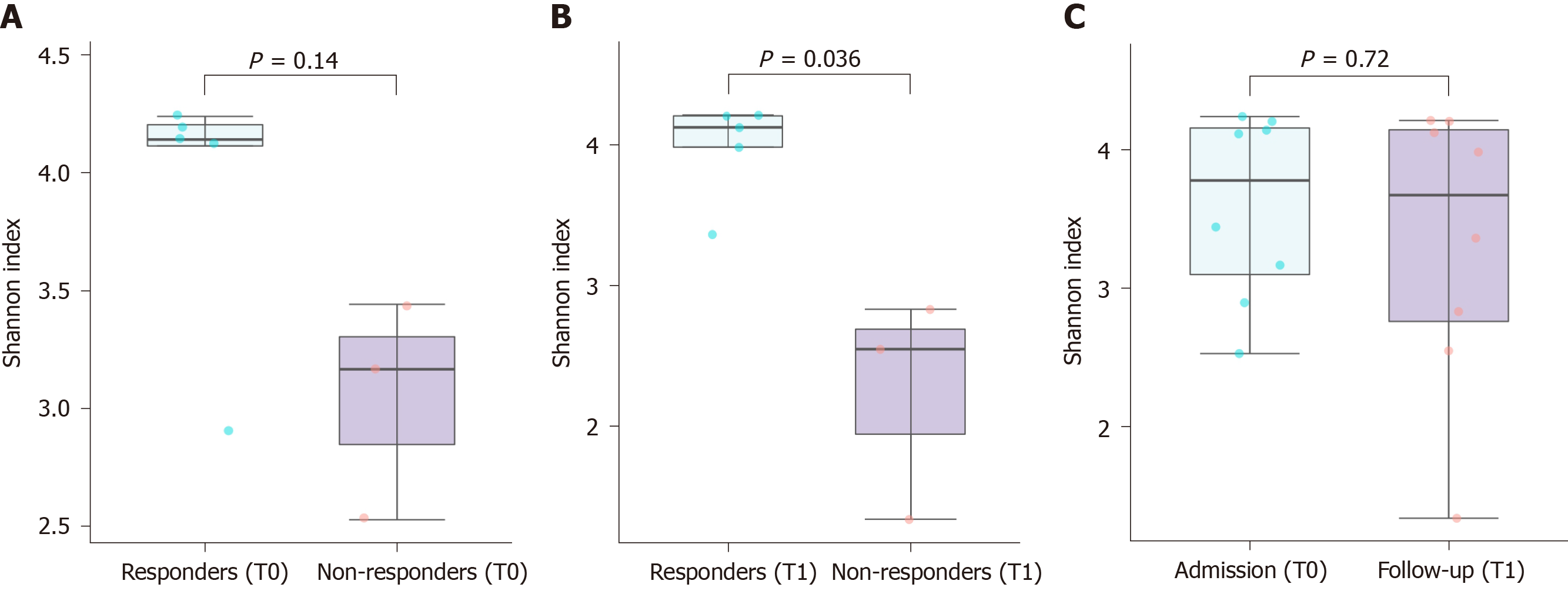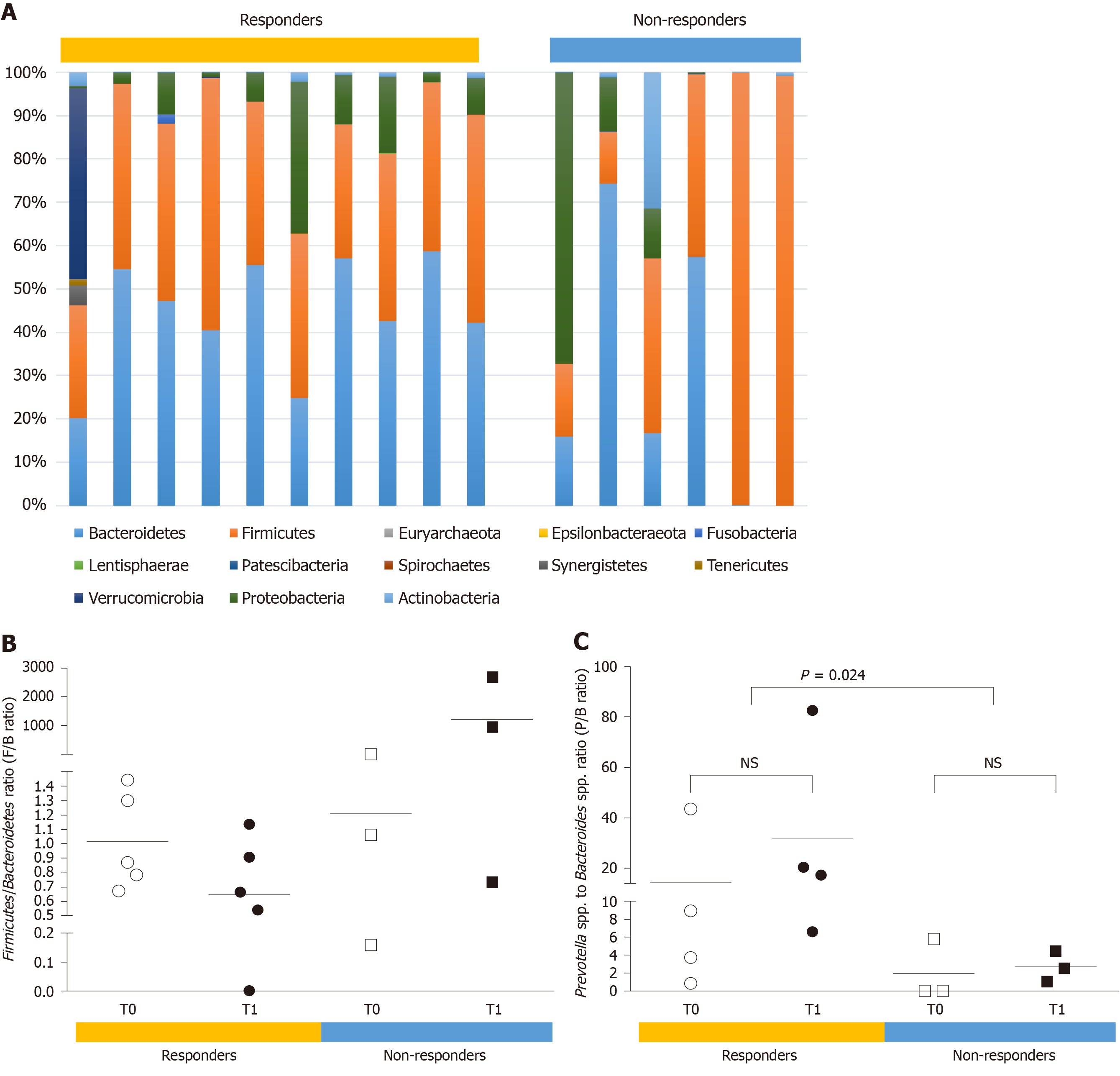Copyright
©The Author(s) 2021.
World J Gastroenterol. Nov 14, 2021; 27(42): 7340-7349
Published online Nov 14, 2021. doi: 10.3748/wjg.v27.i42.7340
Published online Nov 14, 2021. doi: 10.3748/wjg.v27.i42.7340
Figure 1 Alpha diversity indices (Shannon index) of hepatocellular carcinoma patients based on treatment and prognosis.
A: The Shannon index of the non-responders on admission (T0) was not significantly lower than that of the responders (P = 0.14); B: The Shannon index of the non-responders was significantly lower than that of the responders after nivolumab therapy (T1); C: Nivolumab therapy did not alter the Shannon index. HCC: Hepatocellular carcinoma.
Figure 2 Composition of the gut microbiome in hepatocellular carcinoma patients is associated with the response to nivolumab.
A: Heatmap showing the abundance of operational taxonomic units in responders (yellow) and non-responders (blue). The original comprehensive figure, including the names of bacterial taxa, is presented as Supplemental Figure 1; B: Unweighted beta diversity analysis showed that the overall bacterial community structure and phylogenetic diversity at T0 (light yellow and light blue) and T1 (yellow and blue) were similar; distinct clusters were not observed for responders (yellow) and non-responders (blue). Statistical values obtained by the PERMANOVA test are presented in Supplemental Table 2.
Figure 3 Specific bacterial taxa are associated with the prognosis of nivolumab therapy in hepatocellular carcinoma patients according to linear discriminant analysis effect size analysis.
A: Taxonomic cladogram based on linear discriminant analysis (LDA) using effect size (LEfSe) showing differences in fecal taxa. Dot size is proportional to the abundance of the taxon. Letters correspond to the following taxa: (a) Marinifilaceae, (b) Muribaculaceae, (c) Prevotella 9, (d) Alistipes, (e) Rikenellaceae, (f) the Lachnospiraceae NK4A136 group, (g) Roseburia, (h) the [Ruminococcus]gnavus group, (i) Ruminiclostridium 9, (j) the Ruminococcaceae NK4A214 group, (k) Ruminococcaceae UCG-002, (l) Ruminococcaceae UCG-003, (m) Ruminococcaceae UCG-005, (n) Ruminococcaceae UCG-010, (o) Ruminococcaceae UCG-014, (p) Ruminococcus 1, the (q) [Eubacterium]coprostanoligenes group, (r) Dialister, (s) Megamonas, (t) Mitsuokella, and (u) Salmonella; B: LDA scores for the differentially abundant taxa in the fecal microbiome of responders (yellow) and non-responders (blue). The length denotes the effect size for a taxon. P = 0.05 for the Kruskal-Wallis test; LDA score > 3; C: Volcano plot showing several bacterial taxa specifically related to the prognosis of nivolumab therapy in hepatocellular carcinoma patients. LDA: Linear discriminant analysis.
Figure 4 Potential prognostic markers of the response to nivolumab therapy in hepatocellular carcinoma patients.
A and B: At the phylum level, a skewed Firmicutes/Bacteroidetes ratio (< 0.5 or > 1.5) was more frequent in the non-responders than the responders (66.7% vs 10.0%, P = 0.018); C: At the genus level, the ratio of Prevotella species to Bacteroides species (P/B ratio) was a prognostic marker of the response to nivolumab in hepatocellular carcinoma patients. The responders showed a significantly higher mean P/B ratio than the non-responders (22.99 vs 2.312, P = 0.024). NS: Statistically non-specific.
- Citation: Chung MW, Kim MJ, Won EJ, Lee YJ, Yun YW, Cho SB, Joo YE, Hwang JE, Bae WK, Chung IJ, Shin MG, Shin JH. Gut microbiome composition can predict the response to nivolumab in advanced hepatocellular carcinoma patients. World J Gastroenterol 2021; 27(42): 7340-7349
- URL: https://www.wjgnet.com/1007-9327/full/v27/i42/7340.htm
- DOI: https://dx.doi.org/10.3748/wjg.v27.i42.7340












